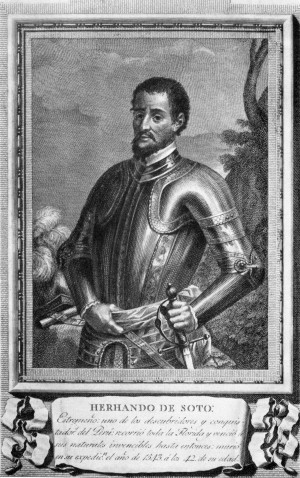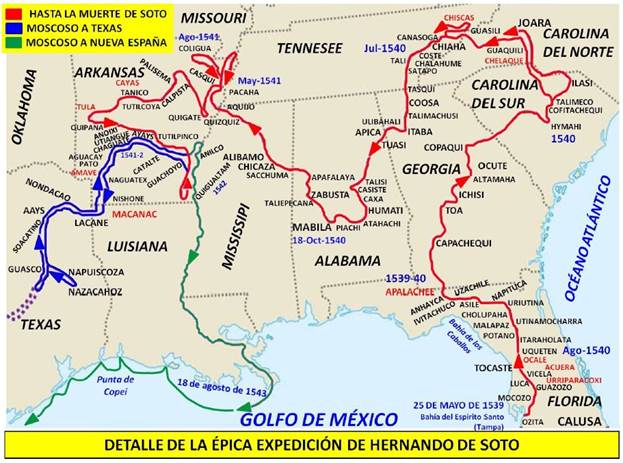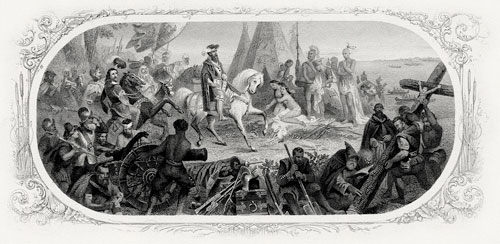
Hernando de Soto, conqueror and explorator
Hernando de Soto, born in Jerez de los Caballeros (Badajoz – Spain), arrived in the Indias in 1514 in the fleet colonization of the governor of Panama Pedrarias Davila. Two years later, he was named captain of cavalry and participated in various conquests in Central America. In 1523 he was in Nicaragua and Honduras with Captain Francisco Fernández de Córdoba. Later, and on his own, he explored the Yucatan peninsula looking for a strait that would allow the passage from the Atlantic to the Pacific, and in 1534 he joined the Francisco Pizarro in the conquest of Peru, for which he obtained a great deal of loot. But this fact failed to satisfy Hernando that he wanted more and his great goal was to conquer great empires as they had already done before. In 1538 he was named Adelantado and captain of all the lands he conquered by Emperor Carlos V. His goal: to conquer Florida and the land north. Juan Ponce de León in 1513 and Pánfilo de Narváez y Cabeza de Vaca in 1528 with dreadful failures.
Expedition to the Florida
Hernando de Soto departed on April 6th,1538 from Sanlúcar de Barrameda (Cádiz -Spain) with eleven ships and 950 men arriving at Santiago de Cuba at the end of May. He sent a first exploratory expedition to Florida led by Captain Añasco to find a suitable landing site. The reports were positive and Hernando de Soto departed from La Havana towards Florida on May 18,1539 with 650 men and 223 horses. It didn’t take them long to arrive, just a week, and they disembarked at Tampa Bay or Bay of the Holy Spirit. In a short time they realized that those lands were unhealthy, damp with asphyxiating heat and plagued with snakes and mosquitoes. Added to this was the hostility of the natives. But this did not scare the expeditionaries who assumed that the more complicated and difficult the conquest, the greater the prize would be.

Once the bridgehead was established in Florida, they marched inland through the winter of 1539 near the Appalachians. In March they continued on their way to the northwest thinking they would find gold mines. They traveled through Georgia and South Carolina, along the Appalachian Mountains, to the present Columbia in South Carolina. But they didn’t find anything. They continued their journey to the northeast crossing territories of numerous North American tribes such as the Altamaha, Ocute, Patofa, Toa, Cherokees, etc. They descended through the present state of Alabama until in October 1540 to the village of Tascaluza where they were received by the chieftain of the same name and nickname Black Warrior. he invited them to visit the village of Mauvila, located a few kilometres away, where an army of 10,000 Indian warriors were waiting to finish them off. Hernando de Soto and his men did not fall into the trap and confronted the Indians who after 9 hours of battle were defeated and a great carnage took place. The Spaniards lost 82 men and 45 horses, as well as a hundred seriously injured. There were also huge losses in material and provisions.
After recovering for a month at the same place of battle, they departed in a northerly direction. The gold must have been over there. They arrived at a tributary of the Mississippi river and found that on the other shore another Indian army was waiting for them ready to avenge their friends from Mauvila. There was a new battle with the result of 40 Spaniards dead and more than 50 horses lost. The situation was getting more and more disastrous, they were turning into a ghostly, ragged and starving army. They were able to rest for two months in the town of Chicaza where they spent the winter healing their wounds and trying to survive. When the weather softened, they continued on their way north to the Mississippi River on May 8th, 1541, where they called the river Rio Grande, and it took them 20 days to cross the river, as they needed to build a boat and canoe and also had to face more than 6,000 Indians who were trying to stop them from crossing it. A whole odyssey.

They crossed Rio Grande, crossed the Arkansas lagoons and climbed the Ozark hills. Winter came again and they had to take refuge in the village of Utiangue, currently Camden or Calion, in Arkansas. Once the cold had passed, they returned to their footsteps and were quite disappointed that they had not been able to find the riches they longed for, they decided to build a couple of canoes and descend the river to the Gulf of Mexico and then continue until Cuba. But the death surprised Hernando de Soto when he became ill with fevers during the month of May or June 1542. Seeing himself so ill and with little hope of survival, Soto named as his successor, Luis de Moscoso Alvarado, nephew of the conqueror Pedro de Alvarado. The survivors set off on their way to the west in search of the road to New Spain, but seeing that it was endless and there was no guarantee of returning, they returned to the Mississippi and resumed Soto’s plan to build the boats and descend the river. They achieved their goal and left for the Gulf of Mexico and arrived at Panuco, the first Spanish settlement on the Mexican coast, in September 1542 and from there they went to Mexico City where they were received by the virrey Mendoza.
Although this expedition was a failure because it did not find great cities or riches, it was a magnificent knowledge of the southern geography of North America, its fauna and flora, as well as its ethnology, making its inhabitants, its lifestyles and the main tribes known. Seeing what there was, that it was not very interesting for the Spaniards, and that there was still no danger of the settlement of other foreign countries, this zone of America was forgotten and the crown’s efforts were based on Florida to protect the access to the Gulf of Mexico and the Caribbean and to explore the Pacific coast of North America.
Index of the conquest and colonization of North America
- Spanish conquest and colonization of North America.- Ponce de león and the Discovery of de Florida.
- Francisco de Garay, Expeditions along the Gulf of Mexico Coast.
- Lucas Vázquez de Ayllón, Foundation of the First Spanish Settlement in North America.
- Esteban Gómez, exploration of the entire east coast.
- Pánfilo de Narváez and Cabeza de Vaca, exploration of the Southern United States
- Nuño de Guzmán, conquistador of Nueva Galicia
- The Viceroy Mendoza and the Seven Cities of Cibola
- Hernando de Soto, the great American marathon
- Francisco Vázquez de Coronado, Arizona y Nuevo México, Texas, Kansas and Oklahoma
- Juan Rodríguez Cabrillo and the discovery of California
- Menéndez de Avilés found San Agustín of the Florida
- Juan de Oñate, the conquest of New Mexico
- The peaceful conquest
- The conquest of Texas, the Missions
- The conquest of California
- Los Caminos Reales Españoles
- The Spanish Alaska
- The Spanish Louisiana
- The loss of North America